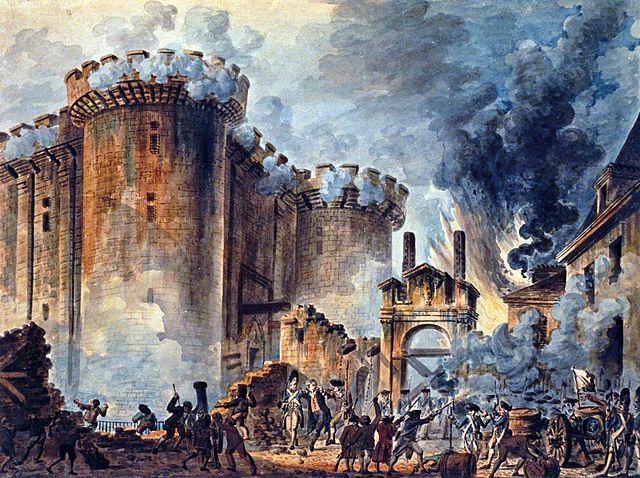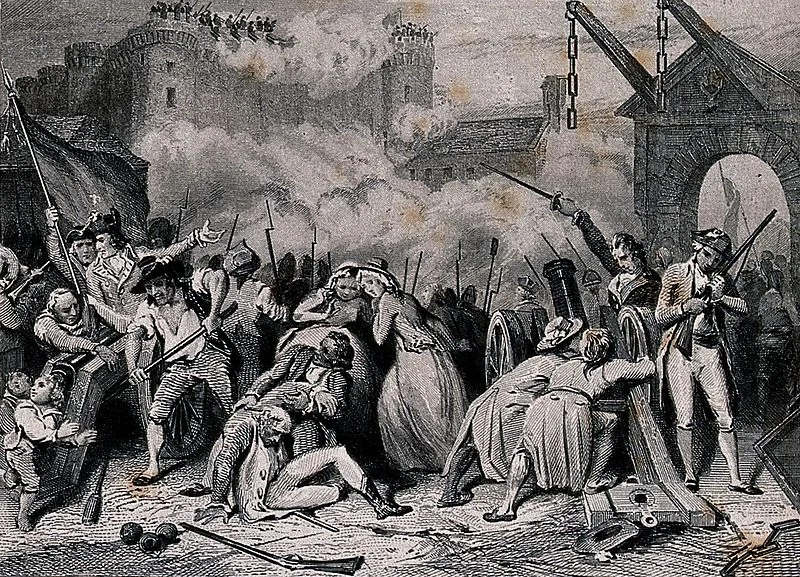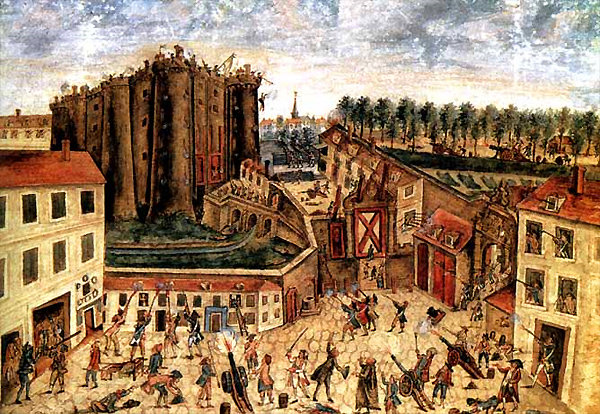La prise de la Bastille by Jean-Pierre Houël, 1789
Why did the French people storm a prison? What caused the French Revolution? What celebrations take place on le 14 juillet? We answer these and other burning questions about Bastille Day.
Down with the king! Long live the republic!
That’s the general sentiment behind Bastille Day in France.
“His head was put on a stake and paraded around Paris as a sign of victory.”
Bastille Day, or the French National Day, is celebrated on July 14th every year in France. It’s a day to celebrate and remember the beginning of the French Revolution. It became a national holiday in France in 1880, less than 100 years after the Storming of the Bastille.
Is it true the French don’t even call it Bastille Day?
Oui. I’m sure most French people would know what you’re talking about nowadays, but for them the holiday is named simply for its date, le 14 juillet (pronounced “le cat-tour jwee-yay”).
What caused the French Revolution?
The population of France had grown dramatically, from about 20 million people in 1700 to 30 million by 1789.
Most were peasant farmers who had to rent their lands from wealthy lords and pay them high taxes to grow crops. The nobility in turn had to give some of this to the king, though they kept most for themselves.
It got so bad that most farmers lived below the poverty level. When the cost of flour rose, people began to starve. And we all know you don’t deprive the French of their beloved baguettes.
King Louis XVI wasn’t able — or simply didn’t care — to solve the problem. He was busy living lavishly and spending an obscene amount of money at his palace in Versailles. Louis XVI had also driven France into bankruptcy by taking the side of the revolutionaries in America, supplying them with a naval fleet.
There were, of course, myriad other factors, including the growing popularity of Enlightenment philosophy. But the long and the short of it is that the downtrodden peasants and politically powerless bourgeoisie eventually had had enough.
The Storming of the Bastille on the 14 July 1789
Why storm the Bastille?
On the morning of July 14, 1789, a group of craftsmen and merchants rose up and invaded Les Invalides, a military hospital, to steal weapons. They successfully ended up with 28,000 rifles — but didn’t have gunpowder to fire them off.
The mob knew that there was a stockpile of gunpowder in the Bastille, the fortress prison that held those who opposed the king. The Bastille was also symbolic to the revolters, representing the monarchy’s absolute and arbitrary power.
Siege of the Bastille by Claude Cholat, 1789
What happened when the mob got to the Bastille?
There weren’t that many soldiers guarding the prison. Still, they weren’t too impressed by the mob — perhaps because the revolutionaries had no way to actually use all those firearms they carried.
The governor of the invalides, Marquis Bernard-René de Launay, met with some representatives of the revolutionaries inside the Bastille. Negotiations ended abruptly when part of the mob found its way into the fortress. The guards were ordered to fire into the crowd, killing hundreds.
De Launay was hoping to gain time until backup appeared. Trouble is, when the so-called rescue team showed up, it decided to fight not for the marquis and the king — but instead on the side of the revolutionaries. Armed with canons, the professional soldiers took over the castle in a few hours’ time.
What happened to the Marquis de Launay and the Bastille guards?
At 4 p.m., the marquis surrendered, and the revolutionaries swarmed in. The guards were killed and de Launay himself was beheaded. His head was put on a stake and paraded around Paris as a sign of victory.
Later that night, 800 or so people ended up burning down the Bastille.
Who were the prisoners at the time?
While Voltaire was one of the more illustrious, previous captives held at the Bastille, at the time of the storming, there were only seven prisoners: one so-called deviant aristocrat, two “lunatics” and four forgers.
What was the king doing about all this?
Historians later found Louis XVI’s diary. On that day, he had only noted the result of his day’s hunt: “Nothing.”
That’s quite an understatement, as the storming of the Bastille became a turning point in the French Revolution, in which Louis XVI and his wife, Marie Antoinette, would be guillotined.
When the king did hear what happened at the Bastille, he famously asked his advisor, “Is this a revolt?” The man answered, “No, Majesty. This is a revolution.”
How do the French celebrate the holiday?
In Paris, there’s a military parade along the Champs-Elysées, which has been decorated with flags. Then the president gives a speech.
In smaller French towns, the mayor gives a speech, followed by the laying of a war memorial wreath.
I know that doesn’t sound overly exciting, but rest assured there are also fireworks, dances, music, food and street celebrations around the country.
Other cities celebrate Bastille Day in style, including Milwaukee, where the festivities go on for four days and involve a replica of the Eiffel Tower.
Bonus Fun Fact!
The British band Bastille takes its name from the fact that July 14 is the birthday of lead singer and songwriter Dan Smith. –Wally























